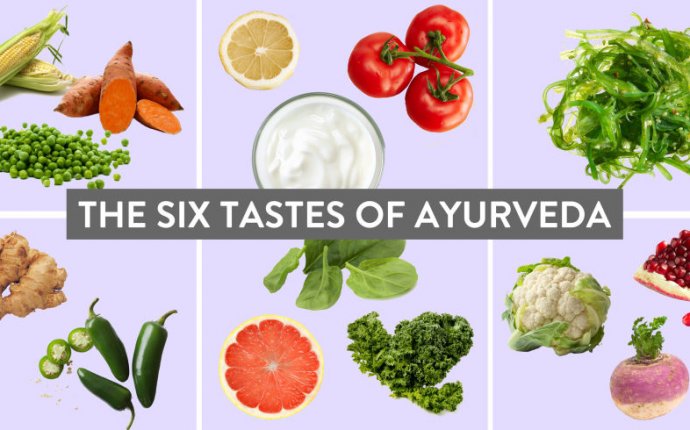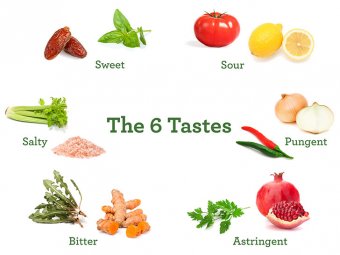
Six tastes of Ayurveda

The Fundamentals of Taste
According to Ayurveda, it is incredibly important to taste our foods, our herbs – our lives. Rasa, the Sanskrit word for taste, has a number of potent meanings, among them: experience, enthusiasm, juice, plasma (as in rasa dhatu), and essence. These diverse meanings only hint at the significance of taste within the Ayurvedic tradition. Rasa is, in a very real way, the essence of life and quite literally affects every aspect of our being – from structure and physiology, straight through to our overall state of mind and consciousness. Ayurveda sees rasa, or taste, as a tremendously powerful therapeutic tool that determines not only how we experience our food, but ultimately, the overall flavor of our existence. Taste is assigned a much deeper significance in Ayurveda than we are accustomed to in the West; it is considered critically important in determining the effect that various foods, spices, therapeutic herbs, and experiences will have on our state of balance – body, mind, and spirit.
Ayurveda recognizes six tastes, each of which has a vital role to play in our physiology, health, and wellbeing. The sweet, sour, salty, pungent, bitter, and astringent tastes combine in countless ways to create the incredible diversity of flavors we encounter throughout our lives. Even the same substance can taste differently, depending on where it is grown or raised, when it is harvested, whether it is stored or preserved, if and how it is cooked or processed, and how fresh or how old it is. Thus, taste can tell us a great deal, not only about what we’re ingesting, but also about the physical and energetic qualities we’re taking in as a result.
In many ways, taste is a living representation of experience: that of the substances we take in, and our own, as we taste them. Ayurveda teaches us to fully acknowledge, appreciate – even relish – the variety of flavors we encounter throughout each day. Only then can we truly harness taste’s potential to affect positive change in our minds and bodies. Tending to the experience of taste also helps us to better understand the six tastes, to cultivate a deeper relationship with each of them, and to begin to adapt our habits according to what we learn.
Breaking Down The Experience of Taste
One of the foundational teachings of the Ayurvedic tradition is that everything in the universe is composed of five elements – earth, water, fire, air, and ether (space). The tastes are no different; each of them contains all five elements. That said, each taste is predominantly composed of two elements.
The 6 Tastes and Their Predominant Elements
| Sweet (Madhura) | Earth & Water |
| Sour (Amla) | Earth & Fire |
| Salty (Lavana) | Water & Fire |
| Pungent (Katu) | Fire & Air |
| Bitter (Tikta) | Air & Ether |
| Astringent (Kashaya) | Air & Earth |
From these elementary beginnings, the experience of taste initiates a complex cascade of influences that touches every aspect of the mind-body organism. For each substance, that mosaic includes its:
- Rasa, or taste (a single taste or a combination of different tastes)
- Aggravating or pacifying effect on each of the doshas (vata, pitta, kapha)
- Virya, or temperature (whether the substance is heating or cooling in nature)
- Vipaka, or post-digestive effect (affects the excreta and nourishes individual cells)
- Prabhava, or an unpredictable action unique to a particular substance (i.e. ghee is cooling and yet it kindles the digestive fire)
- Gunas, or associated qualities
- Affinity for particular organs or tissues
- Direction of movement within the body
- Emotional influence
The combination of all of these factors can affect a wide range of responses in different individuals. While each substance is certainly unique, each of the six tastes tends to exert a somewhat predictable influence on our physiology. If you are interested in the specifics of each taste (energetics, mental and emotional attributes, benefits, potential consequences of overuse, examples, etc.), you’ll find that information here:
If you’d like to understand the particular impact that the different tastes have on each of the three doshas, these resources more specifically highlight those relationships:
The Six Tastes & You
As with most things in Ayurveda, the combination of tastes that’s right for you depends a lot on, well… you – your constitution, your imbalances, your age, your environment. In other words, while each of the tastes is necessary for all of us, the specifics are determined by the context of each individual, and may change over time. A balanced diet will include an appropriate quantity of each of the six tastes, according to one’s constitution (prakriti), current state (vikriti), and season.














